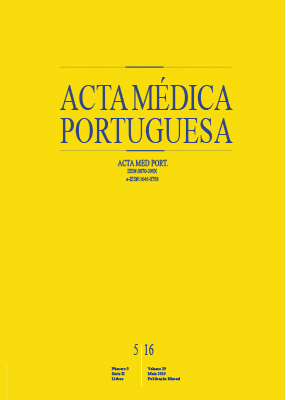Estratégias de Vinculação e Biomarcadores Neuroendócrinos em Crianças Obesas
DOI:
https://doi.org/10.20344/amp.6826Palavras-chave:
Apego ao Objecto, Criança, Obesidade Pediátrica, Sistema Hipotálamo-Hipofisário, Sistema Hipófise-Suprarrenal, Stress Psicológico, Tireotropina.Resumo
Introdução: A qualidade da relação pais-filho influencia o desenvolvimento do sistema fisiológico de regulação do stress da criança. Exploraram-se eventuais associações entre estratégias de vinculação e o cortisol e a hormona estimulante da tiróide, respectivamente como possíveis mediador e variável interveniente na relação mãe-filho, na criança obesa.
Material e Métodos: Foi recrutada na Consulta de Obesidade uma amostra de conveniência de 83 crianças obesas com 10,9 (1,8) anos de idade (46 rapazes). A obesidade foi definida pelo percentil do índice de massa corporal para idade e género e os biomarcadores neuroendócrinos foram medidos pelos métodos de rotina. As estratégias de vinculação foram avaliadas através dos questionários (IACA) para pais e crianças. O funcionamento familiar foi classificado através do preenchimento pelos pais do FACES-III. Foram analisados modelos multivariáveis de regressão linear.
Resultados: As estratégias de vinculação insegura do tipo evitante (tipo A) apresentaram uma associação significativa positiva com os níveis de hormona estimulante da tiróide e negativa com os níveis de cortisol (R2 = 0,352). As estratégias de vinculação segura (tipo B) associaram-se positivamente ao hipotiroidismo e ao percentil de índice de massa corporal, ambas com significado estatístico (R2 = 0,541). As estratégias de vinculação insegura apresentaram alguma evidência de associação positiva com a hormona estimulante da tiróide (R2 = 0,250).
Discussão: Estes achados sugerem a existência de factores comuns na regulação dos eixos hipotálamo-hipófise-adrenal e hipotálamo-hipófise-tiróide. Os processos envolvidos no desenvolvimento das estratégias de vinculação do tipo A parecem associar-se aos mecanismos regulatórios do eixo HPA.
Conclusão: Diferentes estratégias de vinculação estão associadas a diferentes padrões metabólicos em crianças obesas. Desconhece-se qual a sua contribuição para o desenvolvimento e diferenciação da abordagem terapêutica.
Downloads
Downloads
Publicado
Como Citar
Edição
Secção
Licença
Todos os artigos publicados na AMP são de acesso aberto e cumprem os requisitos das agências de financiamento ou instituições académicas. Relativamente à utilização por terceiros a AMP rege-se pelos termos da licença Creative Commons ‘Atribuição – Uso Não-Comercial – (CC-BY-NC)’.
É da responsabilidade do autor obter permissão para reproduzir figuras, tabelas, etc., de outras publicações. Após a aceitação de um artigo, os autores serão convidados a preencher uma “Declaração de Responsabilidade Autoral e Partilha de Direitos de Autor “(http://www.actamedicaportuguesa.com/info/AMP-NormasPublicacao.pdf) e a “Declaração de Potenciais Conflitos de Interesse” (http://www.icmje.org/conflicts-of-interest) do ICMJE. Será enviado um e-mail ao autor correspondente, confirmando a receção do manuscrito.
Após a publicação, os autores ficam autorizados a disponibilizar os seus artigos em repositórios das suas instituições de origem, desde que mencionem sempre onde foram publicados e de acordo com a licença Creative Commons









